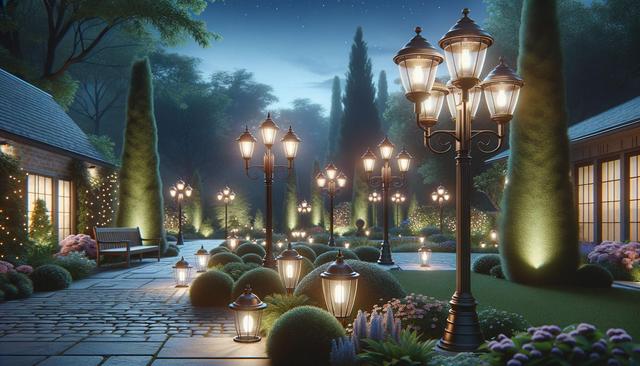Understanding the Role of Outdoor Lighting Design
Outdoor lighting design is much more than placing a few fixtures along a pathway or around a patio. It’s a strategic approach that takes into account the layout of the property, the purpose of the space, and the atmosphere desired. Across the USA, landscape designers and lighting professionals are increasingly focusing on blending form with function. Lighting systems are being designed to illuminate key architectural features, enhance natural elements, and define outdoor living areas, all while ensuring safety and visibility. Properly executed design plans help avoid over-lighting or under-lighting, both of which can negatively impact usability and energy efficiency.
Key considerations in outdoor lighting design include:
- Choosing the right fixture style and material for the environment
- Selecting appropriate light intensity and color temperature
- Using layering techniques to create depth and contrast
- Incorporating smart controls for dynamic lighting adjustments
The result is a cohesive lighting plan that not only beautifies a space but also supports its practical use throughout the evening hours.
Popular Outdoor Illumination Trends in the USA
Trends in outdoor lighting across the USA reflect a growing appreciation for sustainability, technology integration, and personalized aesthetics. One of the most prominent developments is the use of energy-efficient LED lighting. LEDs offer long life spans and lower power consumption, making them a practical choice for both residential and commercial projects. Additionally, smart lighting systems are gaining traction, allowing users to control lighting remotely through mobile apps or home automation devices.
Some current trends in outdoor lighting include:
- Moonlighting: Placing fixtures high in trees to mimic natural moonlight
- Path and step lighting for enhanced safety and ambiance
- Color-changing lights for seasonal or event-based customization
- Minimalist fixtures that blend seamlessly with landscaping
These trends reflect a shift toward lighting that is both functional and expressive, helping property owners create unique nighttime environments.
Benefits of Professional Lighting Installation
While DIY solutions exist, professional installation offers numerous advantages in terms of safety, performance, and design precision. Certified outdoor lighting installers have the expertise to assess terrain, determine power requirements, and choose appropriate fixtures. They also ensure that wiring and connections comply with safety codes and environmental standards. Across the USA, professional services are particularly valued for large-scale or complex projects, such as illuminating expansive gardens, commercial walkways, or public parks.
Key benefits of hiring a professional lighting installer:
- Expert advice on fixture placement and wattage
- Reliable installation that adheres to local regulations
- Access to high-quality, weather-resistant materials
- Ongoing maintenance and support services
Investing in professional installation can lead to better long-term results, with systems that are both durable and easy to manage.
Design Considerations for Different Property Types
Outdoor lighting needs vary depending on the type of property and how the space is used. For residential homes, the focus is often on creating warm, inviting environments for family and guests. This might include lighting for patios, decks, driveways, and garden beds. In contrast, commercial properties may prioritize visibility, security, and brand presentation, using lighting to highlight signage, guide foot traffic, or deter intruders.
Public spaces such as parks, plazas, and municipal buildings also have specific lighting requirements, including:
- Uniform illumination for safety and accessibility
- Low-glare fixtures to reduce light pollution
- Durable materials that withstand frequent use and weather exposure
Each property type benefits from a tailored lighting plan that reflects its unique purpose and audience, ensuring that the installation meets both functional and aesthetic goals.
Energy Efficiency and Maintenance Planning
Long-term efficiency is a top priority in outdoor lighting design and installation. Many property owners in the USA are turning to low-voltage systems, solar-powered fixtures, and timers or motion sensors to reduce energy use. These technologies not only lower utility bills but also support broader environmental goals by minimizing unnecessary light output and energy waste.
Effective maintenance planning is also essential to keep systems running smoothly. This includes:
- Regular inspections to identify faulty bulbs or wiring
- Cleaning lenses and fixtures to ensure optimal light output
- Updating controls or timers to match seasonal changes
By integrating energy-efficient solutions and committing to routine maintenance, property owners can extend the life of their lighting systems and maintain consistent performance over time.
Conclusion: Enhancing Outdoor Spaces with Thoughtful Lighting
Outdoor lighting design and installation in the USA continues to evolve, driven by advancements in technology, changing aesthetic preferences, and a growing emphasis on sustainability. Whether for a private garden, a commercial campus, or a public park, professionally designed lighting systems offer a balance of beauty, safety, and functionality. For homeowners, business managers, and municipal planners alike, investing in quality outdoor lighting is a practical way to enhance the usability and appeal of any space after dark.






